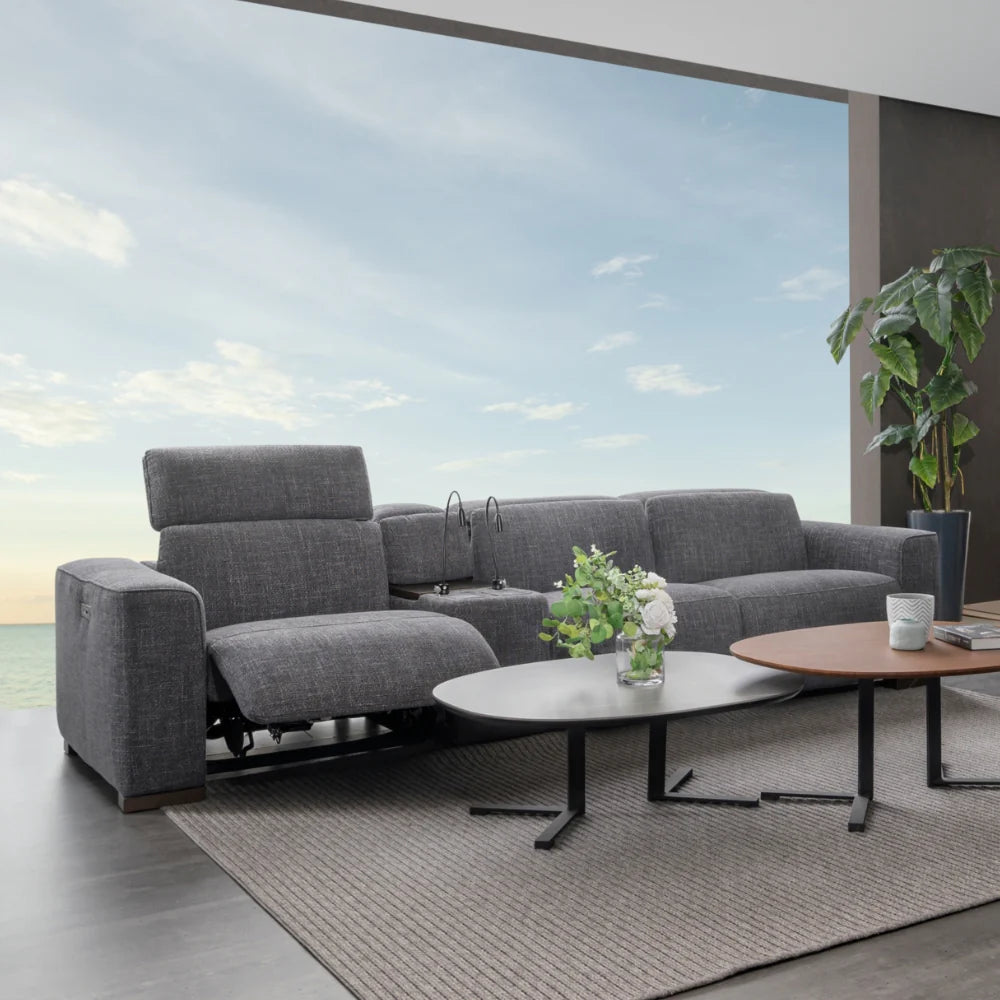Are you feeling confused by the wide range of fabric sofa materials available? Our guide to sofa fabric material types is here to simplify your buying process. COZY'll delve into the best fabric material for sofa, exploring sofa fabric material names and types such as cotton, linen, wool, and more.
This information is crucial for understanding the characteristics, durability, and maintenance requirements of different fabric types. By breaking down these fabric options, we aim to provide you with the need-to-know info to make an informed decision and find the perfect fabric sofa that suits your style and preferences. Let's make sofa shopping easier for you!
Leather Sofas
- Full-Grain Leather: This is the pinnacle of leather quality, featuring the entire grain of the hide. Its natural look and feel, along with its durability, make it a premium choice. Pros include exceptional durability, age beautifully, and it develops a unique patina over time. However, it can be expensive and may have natural markings.
- Top-Grain Leather: Smooth and durable, top-grain leather is slightly thinner than full-grain but retains its quality. It offers a balance between luxury and practicality. Pros include durability, easy maintenance, and a softer feel compared to full-grain. However, it can still be pricey and may not have the same natural appearance as full-grain.
Best use: Versatile for both formal and casual settings.

- Genuine Leather: Made from the lower layers of the hide, genuine leather is real but less durable than top or full-grain. It is softer and more affordable but may not last as long. Pros include affordability and a genuine leather look. Cons include less durability and potential for visible imperfections.
Best use: Budget-friendly options without sacrificing the leather appearance.
- Split Leather: Derived from the layer below the top grain, split leather is softer and has a more suede-like texture. Pros include a luxurious feel, affordability compared to top-grain, and it's often used in more casual settings. However, it may lack the durability of higher-grade leathers.
Best use: Casual and comfortable furniture pieces.
- Bonded Leather: This type is made from shredded leather fibers and a polyurethane binder. While it's more affordable than genuine leather, it's less durable and may not age well. Pros include affordability and a leather-like appearance. Cons include durability concerns and potential for peeling or flaking over time.
Best use: Budget-friendly options for casual spaces.
- Faux Leather: Synthetic leather provides a leather-like appearance without using animal products. Pros include affordability, easy maintenance, and a wide range of colors and styles. However, it lacks the natural feel and durability of real leather.
Best use: Vegan or animal-friendly furniture options with a leather look.

Fabric Sofas
- Microfiber: Known for its softness and durability, microfiber is a synthetic fabric made from finely woven polyester or nylon fibers. Characteristics include a smooth texture, resistance to stains and spills, and easy maintenance. Pros include affordability, stain resistance, and pet-friendly properties. However, it may not have the luxurious feel of natural fibers
. Best use: Family-friendly spaces, high-traffic areas.

- Velvet: Typically made from a blend of materials to achieve their characteristic softness and sheen. The most common materials used in velvet fabric include cotton, silk, polyester, rayon and nylon. Its characteristics include a smooth feel, excellent durability, and a luxurious appearance. Pros include its elegant look, durability, and ability to add a touch of luxury to any room. However, velvet can be more challenging to clean and may show imprints or marks.
Best use: Formal living rooms, accent pieces.
- Chenille: Textured fabric known for its softness and warmth. It has a velvety appearance due to its fuzzy yarns. Characteristics include a cozy feel, durability, and a textured look. Pros include its comfort, durability, and resistance to wrinkles. However, it may attract pet hair and be prone to snagging
Best use: Cozy living spaces, casual settings.
- Linen: Natural fabric made from flax fibers, known for its breathability and casual elegance. Characteristics include a crisp texture, natural luster, and good moisture absorption. Pros include its lightweight feel, breathability, and timeless appeal. However, linen can wrinkle easily and may require professional cleaning.
Best use: Light and airy interiors, summer homes.

- Cotton: Versatile and widely used natural fabric known for its softness and comfort. Characteristics include breathability, absorbency, and easy care. Pros include its comfort, durability, and natural hypoallergenic properties. However, cotton can wrinkle and may fade over time with frequent washing.
Best use: Casual and comfortable settings, everyday use.
- Wool: Natural fiber known for its warmth and resilience. Characteristics include insulation, moisture-wicking properties, and a soft feel. Pros include its warmth, durability, and natural flame resistance. However, wool may require special care and can be prone to shedding.
Best use: Cooler climates, cozy and inviting spaces.
- Acrylic: Synthetic fiber that mimics the softness and warmth of wool. Characteristics include durability, color retention, and resistance to mildew and moths. Pros include affordability, easy maintenance, and resistance to fading. However, acrylic may not have the same natural feel as wool.
Best use: Outdoor furniture, budget-friendly options.
- Polyester: Synthetic fabric known for its strength and durability. Characteristics include wrinkle resistance, quick drying, and color retention. Pros include affordability, easy maintenance, and resistance to stains. However, polyester may not breathe as well as natural fibers and can feel less luxurious.
Best use: High-traffic areas, families with children or pets.

- Nylon: Synthetic fiber known for its strength and resilience. Characteristics include abrasion resistance, elasticity, and easy maintenance. Pros include durability, stain resistance, and colorfastness. However, nylon may not have the softness of other fabrics and can be prone to static electricity.
Best use: Upholstery in busy areas, commercial spaces.
Factors To Consider When Choosing Sofa Fabric
- Durability and wear resistance are crucial factors to consider when choosing fabric sofa materials. Fabrics like microfiber, polyester, and nylon are known for their durability and ability to withstand daily wear and tear. They are less prone to pilling, fading, and fraying, making them ideal choices for busy households.
- The ease of cleaning and maintenance fabric sofa is another key consideration. Opt for fabrics that are easy to clean and maintain, such as those with stain-resistant finishes or removable, machine-washable covers. This ensures that your sofa stays looking fresh and new for longer, with minimal effort required.
- Comfort and texture play a significant role in the overall enjoyment of your sofa. Fabrics like velvet, chenille, and linen offer a soft, luxurious feel that enhances your lounging experience. Consider your preferences for texture and choose a fabric that feels comfortable against your skin.

- For individuals with allergies or sensitivities, it's essential to select hypoallergenic fabrics that won't exacerbate symptoms. Natural fibers like cotton and linen are breathable and less likely to trap allergens, making them suitable choices for allergy sufferers.
- Lastly, consider your style and aesthetic preferences why choose a fabric sofa. Whether you prefer classic, traditional designs or modern, contemporary styles, there are fabric options available to suit every taste. Experiment with different type of upholstery fabric and explore various colors, patterns, and textures to find the perfect match for your home décor and personal style.
Conclusion
Fabric sofa materials such as leather, cotton, linen and wool... all have their own characteristics and are suitable for different needs, including affordable to high-end options, meeting diverse preferences. Therefore, we should be aware of the warning signs when shopping for a sofa and upholstery to help avoid common pitfalls.
Whether you’re looking for elegant living room sofas or ordinary sofas, choosing the right couch fabric is crucial. COZY’s sofa collections offer a variety of options that meet style, comfort, and durability needs, making it easy to find the perfect fabric sofa for any home. With various types of sofas, including premium fabric sofas, there’s something to cater to every preference.





